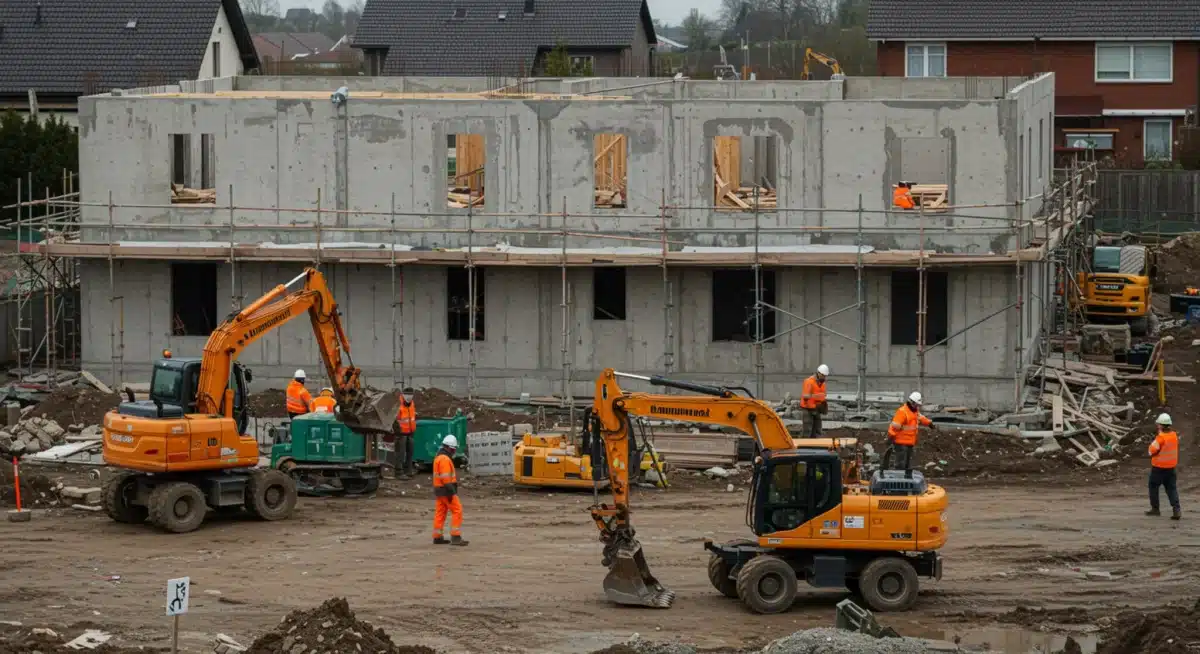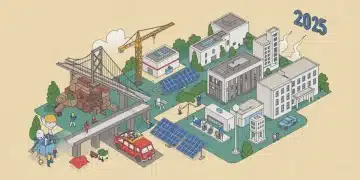Declining US Housing Market 2025: Economic Impact

The projected decline in the US housing market in 2025 signifies potential widespread economic repercussions, impacting consumer confidence, investment, and employment across various sectors, demanding strategic adaptations from policymakers and businesses.
Understanding what the declining housing market means for the broader US economy in 2025 is crucial for homeowners, investors, and policymakers alike. The housing sector is often a bellwether for economic health, and any significant downturn can ripple through various industries, affecting everything from employment to consumer spending. As we look towards 2025, several factors suggest a potential contraction, prompting a closer examination of its likely consequences.
The Current State of the US Housing Market
The US housing market has experienced unprecedented fluctuations over the past few years, driven by a confluence of factors including historically low interest rates, supply chain disruptions, and shifting demographic trends. While recent years saw rapid appreciation and intense competition, the landscape is now showing signs of cooling, with some regions already witnessing price corrections.
This evolving scenario is largely influenced by the Federal Reserve’s monetary policies aimed at curbing inflation. Rising interest rates have directly impacted mortgage affordability, pushing many prospective buyers out of the market. Furthermore, inventory levels, while still historically low, are gradually increasing, offering buyers more options but also potentially signaling a softening demand. The interplay of these forces sets the stage for a potentially challenging period ahead.
Mortgage Rates and Affordability Challenges
Mortgage rates have soared from their pandemic-era lows, significantly increasing the monthly cost of owning a home. This shift has had a profound effect on affordability, particularly for first-time buyers and those in lower to middle-income brackets.
- Increased Monthly Payments: Higher rates translate to substantially larger mortgage payments for the same loan amount, reducing purchasing power.
- Reduced Buyer Pool: Many potential buyers are priced out of the market, leading to decreased demand and longer listing times.
- Impact on Refinancing: Existing homeowners with lower rates are less likely to move, further constricting inventory.
The persistent challenge of affordability continues to be a central theme in discussions about the housing market’s trajectory. As wages struggle to keep pace with housing costs and borrowing expenses, the dream of homeownership becomes increasingly distant for a significant portion of the population. This dynamic is a key driver of the anticipated decline.
In summary, the current housing market is navigating a complex environment characterized by tighter monetary policy and persistent affordability issues. These elements are collectively contributing to a shift from the seller’s market dominance of recent years towards a more balanced, or even buyer-favored, landscape as 2025 approaches.
Economic Indicators Signaling a Downturn
Several key economic indicators are currently flashing warning signs regarding the future of the housing market and its potential impact on the broader economy. These signals, when viewed collectively, paint a picture of an economy bracing for significant adjustments. Understanding these indicators is essential for anticipating the scale and scope of the anticipated downturn.
Consumer confidence, a vital measure of economic sentiment, has been volatile, reflecting anxieties about inflation, job security, and overall economic stability. A dip in confidence often precedes reduced spending on big-ticket items like homes, further exacerbating a market slowdown. Additionally, the labor market, while resilient, shows signs of cooling, which could impact household incomes and their ability to sustain housing payments.
Consumer Confidence and Spending Habits
Consumer confidence plays a pivotal role in the housing market. When individuals feel secure about their financial future, they are more likely to make large investments such as purchasing a home. Conversely, a decline in confidence often leads to caution and a postponement of such significant decisions.
- Reduced Major Purchases: Uncertainty typically leads to consumers delaying or canceling plans for home buying or renovations.
- Savings Prioritization: Households may prioritize saving over spending, further tightening the flow of capital into the housing sector.
- Impact on Durable Goods: A slowdown in housing also affects related industries, such as furniture, appliances, and home improvement, as new home sales drive demand for these items.
The delicate balance between consumer optimism and economic reality is a powerful determinant of market activity. As inflationary pressures persist and interest rates remain elevated, the willingness of consumers to engage in the housing market is likely to diminish, contributing to the broader economic slowdown.
The confluence of these economic indicators suggests a period of adjustment for the US economy, with the housing sector acting as a primary channel through which these changes will manifest. Monitoring these signals will be critical for understanding the evolving economic landscape.
Impact on Related Industries and Employment
A declining housing market extends its reach far beyond just real estate agents and mortgage brokers; it sends ripples throughout a vast network of interconnected industries. The construction sector, in particular, is highly sensitive to housing market fluctuations, as new builds and renovations directly correlate with economic activity in this area. A slowdown here can have significant employment consequences.
Beyond construction, industries such as manufacturing (for building materials), retail (for home furnishings and appliances), and even financial services (beyond mortgages) feel the pinch. When fewer homes are sold, there’s less demand for new furniture, less need for moving services, and reduced activity for legal and appraisal professionals. This interconnectedness means a housing downturn can quickly become a broader economic challenge.
Construction Sector Downturn
The construction industry is often the first to feel the impact of a cooling housing market. Reduced demand for new homes leads to fewer building permits, scaled-back projects, and ultimately, job losses for construction workers.

- Job Losses: A decrease in new construction projects directly impacts employment for laborers, electricians, plumbers, and various tradespeople.
- Material Demand: Suppliers of lumber, steel, concrete, and other building materials experience reduced orders, affecting their revenue and workforce.
- Developer Confidence: Developers may postpone or cancel future projects, further slowing down the pipeline of new housing inventory.
The ripple effect of a construction slowdown is substantial, impacting local economies where these projects are major employers. The broader implications for employment rates and consumer spending among these affected workers cannot be overstated.
Furthermore, the retail sector, particularly businesses specializing in home goods, furniture, and appliances, also faces headwinds. New homeowners are primary consumers of these products, and a decline in home sales translates directly to reduced demand in these retail segments. This can lead to decreased sales, inventory gluts, and potential layoffs, adding to the overall economic strain. The interconnectedness of these sectors underscores why the health of the housing market is so vital to overall economic stability and job creation.
Potential Policy Responses and Government Intervention
In the face of a potentially declining housing market, government bodies and central banks typically consider a range of policy responses aimed at stabilizing the economy and mitigating adverse effects. These interventions can vary widely, from monetary policy adjustments by the Federal Reserve to fiscal stimuli enacted by Congress. The goal is often to prevent a severe downturn from spiraling into a broader recession while also protecting vulnerable homeowners.
One common approach involves the Federal Reserve adjusting interest rates. If the housing market decline appears to be dragging down overall economic growth, the Fed might consider lowering its benchmark interest rate to make borrowing cheaper, thereby stimulating demand for mortgages and housing. However, such decisions are complex, balancing the need to support housing with the ongoing fight against inflation.
Monetary Policy Adjustments
The Federal Reserve holds significant sway over the economy through its monetary policy tools. Interest rate adjustments are a primary mechanism for influencing housing market activity.
- Interest Rate Cuts: Lowering the federal funds rate can reduce mortgage rates, making homeownership more affordable and stimulating buyer demand.
- Quantitative Easing: In more severe scenarios, the Fed might resume purchasing mortgage-backed securities to inject liquidity into the market and keep long-term rates low.
- Forward Guidance: Clear communication about future policy intentions can help stabilize market expectations and encourage lending.
The effectiveness of monetary policy depends on the underlying causes of the housing decline and the broader economic context. A cautious and data-driven approach is essential to avoid unintended consequences.
Fiscal policy, managed by the government, can also play a crucial role. This might include tax credits for first-time homebuyers, direct financial assistance programs for struggling homeowners, or investments in affordable housing initiatives. These measures aim to directly support demand and prevent foreclosures, thereby stabilizing communities and the housing stock. The balance between these monetary and fiscal tools is key to a comprehensive and effective response to a declining housing market in 2025.
Regional Variations and Their Economic Implications
It is crucial to recognize that the US housing market is not a monolith; rather, it is a collection of diverse regional markets, each with its unique dynamics. While national trends provide a general overview, the impact of a declining housing market in 2025 will likely be felt unevenly across different geographic areas. Some regions, particularly those that experienced rapid price appreciation and speculative buying, may face more significant corrections, while others with more stable economies and housing fundamentals might see milder adjustments.
Understanding these regional variations is vital for accurate forecasting and targeted policy interventions. Factors such as local job growth, population shifts, housing supply, and the prevalence of remote work can all contribute to how a specific market responds to broader economic pressures. A one-size-fits-all approach is unlikely to be effective in addressing the nuanced challenges presented by a widespread housing market decline.
High-Growth vs. Stable Markets
Regions that saw explosive growth during the pandemic, often driven by an influx of remote workers and low interest rates, are typically more vulnerable to corrections. These areas may experience sharper price declines and increased inventory.
- Speculative Markets: Areas with high investor activity and rapid price increases are prone to more pronounced downturns as speculative bubbles burst.
- Resilient Markets: Regions with strong underlying economic fundamentals, diverse job markets, and steady population growth may experience more moderate adjustments.
- Supply and Demand Imbalance: Markets with chronic housing shortages might retain more value, even amidst a national slowdown, due to persistent demand.
The disparity in regional performance highlights the importance of localized analysis. What constitutes a significant decline in one market might be a minor correction in another, reflecting the varied economic landscapes across the country.

For example, a tech hub that saw a massive influx of residents and a surge in housing prices might face a more severe correction if tech layoffs become widespread. Conversely, a state with a stable manufacturing base and a steady housing supply might weather the storm with less volatility. These regional differences underscore the complexity of forecasting and responding to a national housing market decline, requiring granular data and tailored strategies to address specific local conditions effectively.
Long-Term Economic Outlook Beyond 2025
While the immediate focus is on what the declining housing market means for the broader US economy in 2025, it is equally important to consider the long-term implications and potential recovery trajectories. Economic cycles are inherent, and while a downturn can be challenging, it also often paves the way for future growth. The question isn’t just about the decline, but how the economy adapts, rebuilds, and strengthens in its wake.
Beyond 2025, the housing market’s trajectory will likely be influenced by demographic shifts, technological advancements, and evolving consumer preferences. The millennial generation, for instance, is still a significant force in the housing market, and their continued entry into homeownership will provide a baseline of demand. Furthermore, innovations in construction techniques and financing models could reshape affordability and supply dynamics.
Demographic Shifts and Future Demand
Demographics play a crucial role in shaping long-term housing demand. The continued maturation of younger generations, coupled with migration patterns, will be key determinants of market recovery.
- Millennial Homeownership: This large demographic cohort will continue to drive demand for starter homes and move-up properties.
- Aging Population: The increasing number of retirees may lead to demand for smaller, more accessible housing options or a shift in housing preferences.
- Migration Patterns: Shifting populations towards more affordable or amenity-rich areas will create new demand centers and influence regional market performance.
Understanding these demographic currents is essential for anticipating where and how housing demand will evolve in the years following 2025.
Technological innovations in construction, such as modular building and 3D printing, could potentially address long-standing supply shortages and improve housing affordability over the long term. These advancements, combined with evolving financing solutions, might help to create a more resilient and accessible housing market. While 2025 may present challenges, the underlying forces of demand and innovation suggest that the US housing market will eventually find its footing and contribute to sustained economic growth.
| Key Aspect | Brief Impact Summary |
|---|---|
| Consumer Spending | Reduced confidence and wealth effect may lead to decreased spending on goods and services. |
| Employment | Job losses expected in construction, real estate, and related sectors. |
| Financial Stability | Potential for increased loan defaults and stress on financial institutions. |
| Government Response | Likely monetary and fiscal interventions to stabilize the market and economy. |
Frequently Asked Questions About the 2025 Housing Market
While a declining housing market can significantly impact economic growth, it doesn’t automatically guarantee a recession. The outcome depends on the severity of the decline and the resilience of other economic sectors, along with timely policy responses. Other factors like global trade and consumer confidence also play a crucial role.
High interest rates significantly reduce housing affordability, making mortgages more expensive. This typically leads to decreased buyer demand, longer listing times, and potential price corrections, contributing to a cooler market in 2025. The Fed’s stance on inflation will be key.
Homeowners face risks such as reduced home equity, making it harder to sell or refinance. Those with adjustable-rate mortgages might see payment increases. Additionally, a broader economic slowdown could impact job security, making mortgage payments more challenging. Maintaining an emergency fund is crucial.
Regions that experienced rapid price appreciation, high levels of speculative buying, and have less diverse local economies are generally more vulnerable. Areas with significant reliance on a single industry or those with an oversupply of homes may also face steeper corrections. Tech hubs and certain Sun Belt cities could be at risk.
Government intervention, through monetary policies like interest rate adjustments or fiscal measures such as homeowner assistance, can significantly mitigate the severity of a housing downturn. However, complete prevention of a market correction is unlikely, as market forces are powerful. The goal is typically to ensure a soft landing.
Conclusion
The prospect of a declining US housing market in 2025 presents a complex set of challenges and opportunities for the broader economy. From shifting consumer behaviors and potential employment impacts across various sectors to the critical role of policy responses, the interconnectedness of housing with overall economic health is undeniable. While certain indicators suggest a period of adjustment, careful monitoring, strategic planning, and adaptive policies can help navigate these turbulent waters. The long-term outlook, shaped by demographic trends and innovation, suggests that despite short-term volatility, the housing market will continue to be a foundational pillar of the American economy, evolving to meet future demands.





